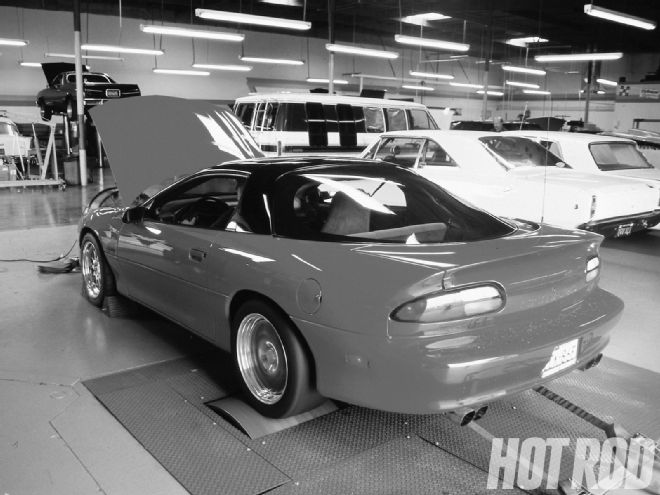
We'd like to thank Dave Mikels of Hypertech's Tuning Department for the data that follows. Mikels' interest and skills directed to this phase of the company's activities are extensive. Thank heavens the man has no grasp of the nine-to-five ethic. -Ed
The introduction of Chevy's all-new small-block has heralded fresh challenges among the aftermarket computer-hacking community. In years past, Hypertech provided chip-power programs that were based on its ability to reprogram and replace "chips" or program read only memories (PROMs) in an OEM computer. Alas, those geezers are no longer an option with OBD-II. They've been overthrown by "flash memory" chips that require the ability to legally unscramble OEM computer codes and program new information in accordance with increased combustion efficiency.
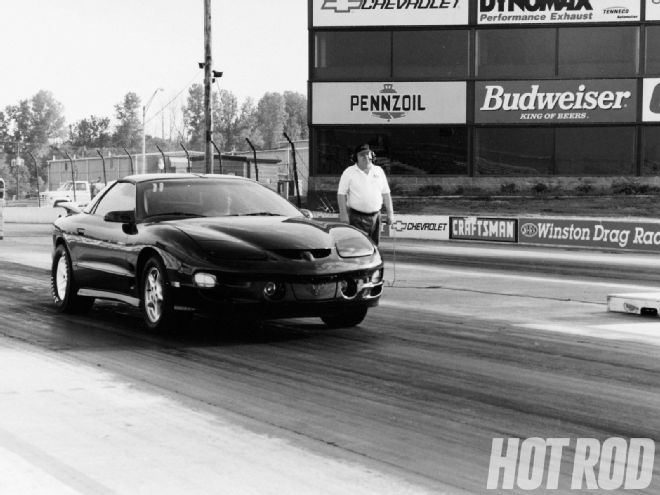
Hypertech's descrambler, the Power Programmer III (PPIII), enables a range of tuning geared to combinations of basic bolt-on parts. Headers, cams, after-cat systems, fresh-air packages, and related components all require adjustments to ignition spark and fuel delivery for optimum performance. The price of the programmer was undecided at press time. Undoubtedly, it won't be cheap. Tuning for the LS-derived truck engines (4.8L/5.3L) is under way. Early indications are that the benefits for the trucks will parallel those for the F-body LS1s.
You will also note the results from changing the thermostat temperature range and the installation of Hypertech's new Power Pulleys. Powerstat thermostats are available in 160- and 180-degree versions, both of which help maintain lower combustion-chamber surface temperatures for subsequent performance benefits.
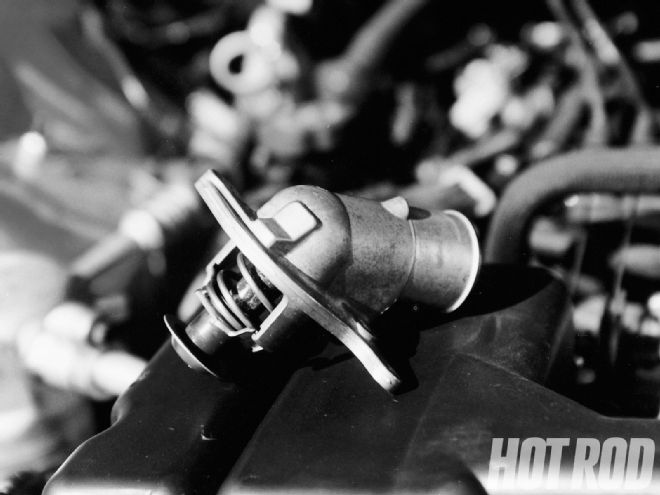
Basic Tuning Procedure- All of the data was collected with a DynoJet 248C chassis dyno; all of the data was weather corrected. NOTE: While the correction factors are directly applicable to the dyno readings, the OEM power control module (PCM) performs its own internal corrections that can reflect upon the indicated level of power. To ensure the accuracy of the final performance data, Hypertech performs frequent baseline tests-as well as back-to-back testing to compare its tuning to that of the OEM-to compensate for minor variations. Calibrations made with unleaded premium fuel and all OEM engine and emission controls intact.
Thermostat- A "cooler" thermostat allows more aggressive tuning, just short of detonation. Cooler thermostats (160 and 180 degree) are available for the LS1 (F-body) engine and are intended to maintain lower combustion-chamber temperatures, enabling spark and fuel recalibrations to provide increased power over a longer period. Higher operating temperatures, caused by the 195-degree thermostat, prevent increased spark timing or fuel enrichment, thereby reducing net power and performance obtainable by precise spark and fuel calibration upgrades as enabled by the PPIII.
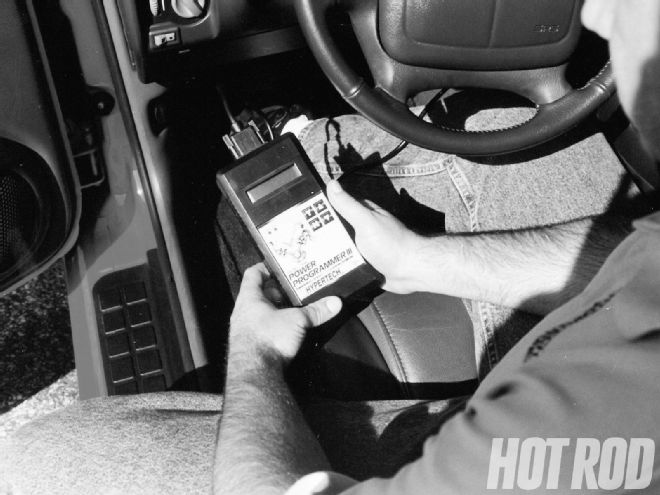
Power Pulleys-The benefits from reduced inertial loadings of a rotating mass are wholly evident. On average, the installation of Hypertech's Power Pulleys enabled a corrected rear-wheel power increase of 9.7 hp and 9.3 lb-ft of torque.
Quarter-Mile Performance Stock Tuning 1 2 3 Average 60' 2.052 2.071 2.094 2.072 330 5.852 5.901 5.938 5.897 1/8 8.959 9.027 9.075 9.020 MPH 80.10 79.62 79.36 79.69 1,000 11.622 11.704 11.758 11.695 1/4 13.908 14.003 14.062 13.991 MPH 98.29 97.79 97.50 97.86
Hypertech PPIII Tuning 4 5 6 7 Average Improvement 60' 2.051 2.052 2.031 2.033 2.042 0.031 330 5.834 5.814 5.795 5.778 5.805 0.092 1/8 8.920 8.898 8.866 8.846 8.883 0.138 MPH 80.63 80.57 80.96 80.92 80.77 1.08 1,000 11.570 NA 11.506 NA 11.538 0.157 1/4 13.844 13.826 13.771 13.747 13.797 0.194 MPH 98.81 98.46 99.30 99.10 98.92 1.06
Vehicle:
1998 Pontiac Trans Am 5.7L LS1 Automatic
3.23:1 Axle
PPIII/180 Stat/Power Pulleys
Highlights of the Hypertech Power Programmer III
1. Engine tuning (including spark and fuel calibrations)
2. Cooling-fan operation-provides three settings (stock 195-degree, 180-degree, and 160-degree thermostats)
3. Engine-rev limiter adjustment
4. Top-speed limiter adjustment
5. Transmission-shift firmness
6. Transmission-shift-point adjustment (for First to Second, Second to Third, and Third to Fourth shifts)
7. Tire-size change correction for speedometer and shift points (in 1/4-inch increments)
8. Rear-axle ratio change for speedometer and shift points for all popular gearsets
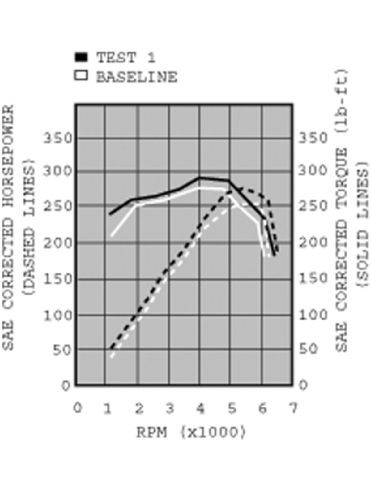
'98 Pontiac T/A
(auto trans, 3.23:1)
Baseline:
Power: 251.6 hp
Torque: 278.1 lb-ft
PPIII:
Power: 273.1 hp
Torque: 290.6 lb-ft
• Stock, including pulleys and 195-degree thermostat. Gains were made with the PPIII and no other modifications. The improvement in acceleration from 1,000-6,000 rpm was 0.55 seconds.
• Corrected rear-wheel hp gain = 21.5 hp @ 5,500 rpm.
• Corrected rear-wheel torque gain = 12.5 lb-ft @ 1,500 rpm.
Note: Trans was locked in Second gear; torque converter was also locked.
• Elapsed time (e.t.) acceleration on the chassis dyno (Second gear from 1,250-6,250 rpm) showed an improvement of 0.57 seconds.
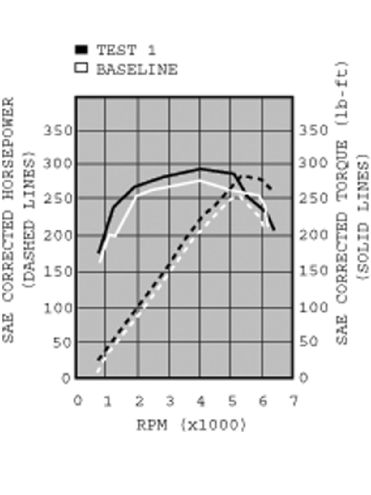
'98 Pontiac T/A
(six-speed, 3.42:1)
Baseline:
Power: 296.0 hp
Torque: 319.5 lb-ft
PPIII, pulleys: Power: 312.3 hp Torque: 329.3 lb-ft
• The addition of pulleys elevated the corrected rear-wheel hp gain by 9.7 and corrected rear-wheel torque by 9.3 lb-ft. Gains from inertial load reduction are not evident until approximately 2,500 rpm. On-dyno acceleration e.t. was reduced by 0.26 seconds.
• Corrected rear-wheel hp gain = 16.3 hp @ 5,250 rpm.
• Corrected rear-wheel torque gain = 9.8 lb-ft @ 1,000 rpm.
• Elapsed time (e.t.) acceleration on the chassis dyno (Fourth gear from 1,000-6,000 rpm) showed an improvement of 0.59 seconds.
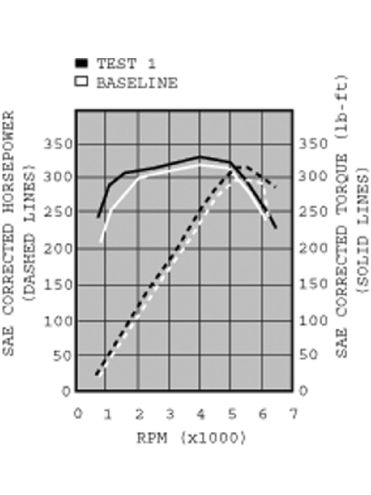
'98 Pontiac T/A
(auto trans, 3.23:1)
Baseline:
Power: 259.8 hp
Torque: 277.2 lb-ft
PPIII, pulleys, 180-degree thermostat:
Power: 281.5 hp
Torque: 296.4 lb-ft
• Corrected rear-wheel hp gain = 21.7 hp @ 5,000 rpm.
• Corrected rear-wheel torque gain = 19.2 lb-ft @ 1,500 rpm.
Note: Trans was locked in Second gear; torque converter was also locked. Hypertech PPIII, Power Pulleys, and 180-degree Hypertech Powerstat installed.
• Quarter-mile performance showed e.t. reduction of 0.21 seconds and an additional 1.09 mph by changing the stock tuning to PPIII tuning.
• Elapsed time (e.t.) acceleration on the chassis dyno (1,000-6,000 rpm) showed an improvement of 0.55 seconds, correlating to an 8-percent gain in acceleration performance over the baseline run.